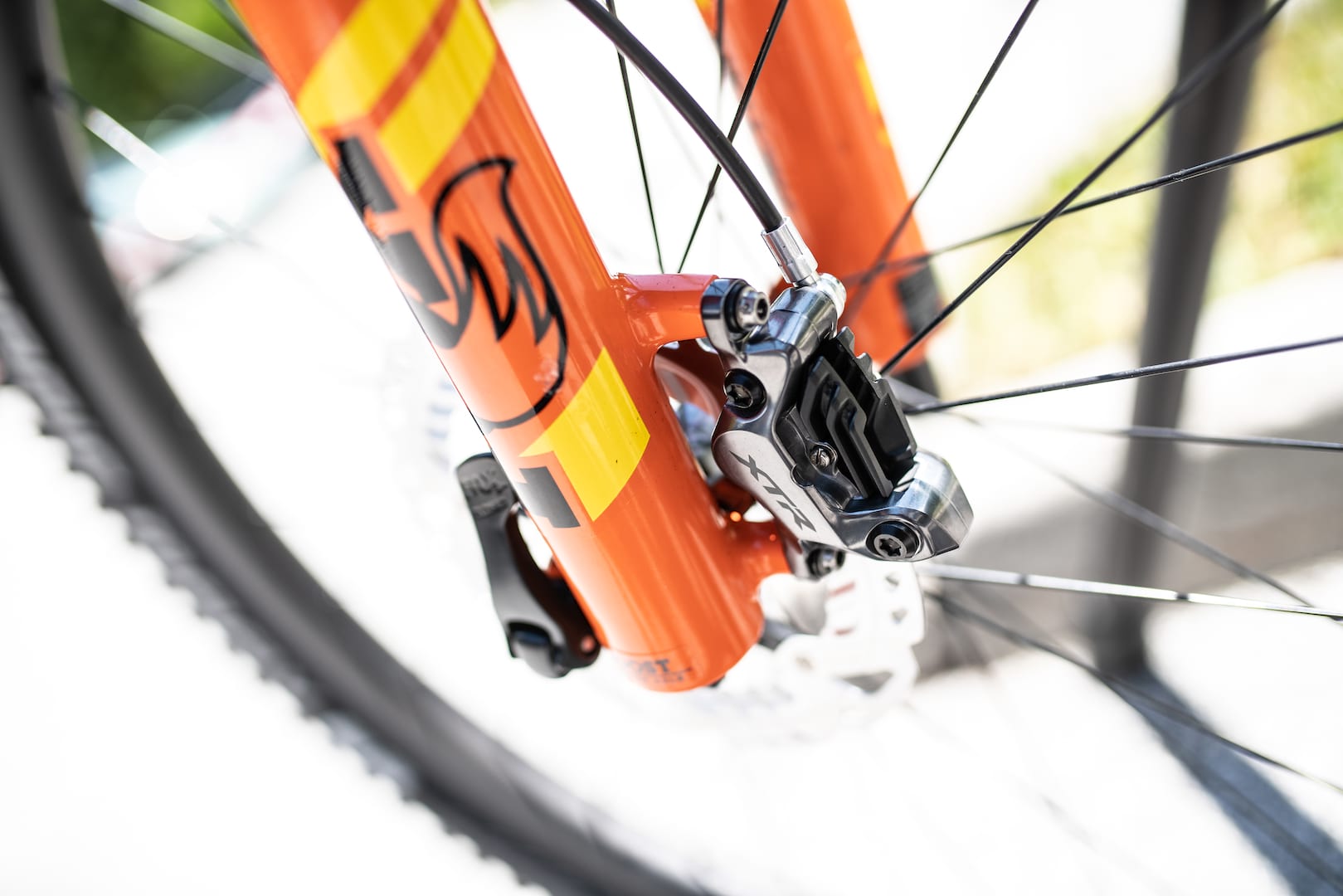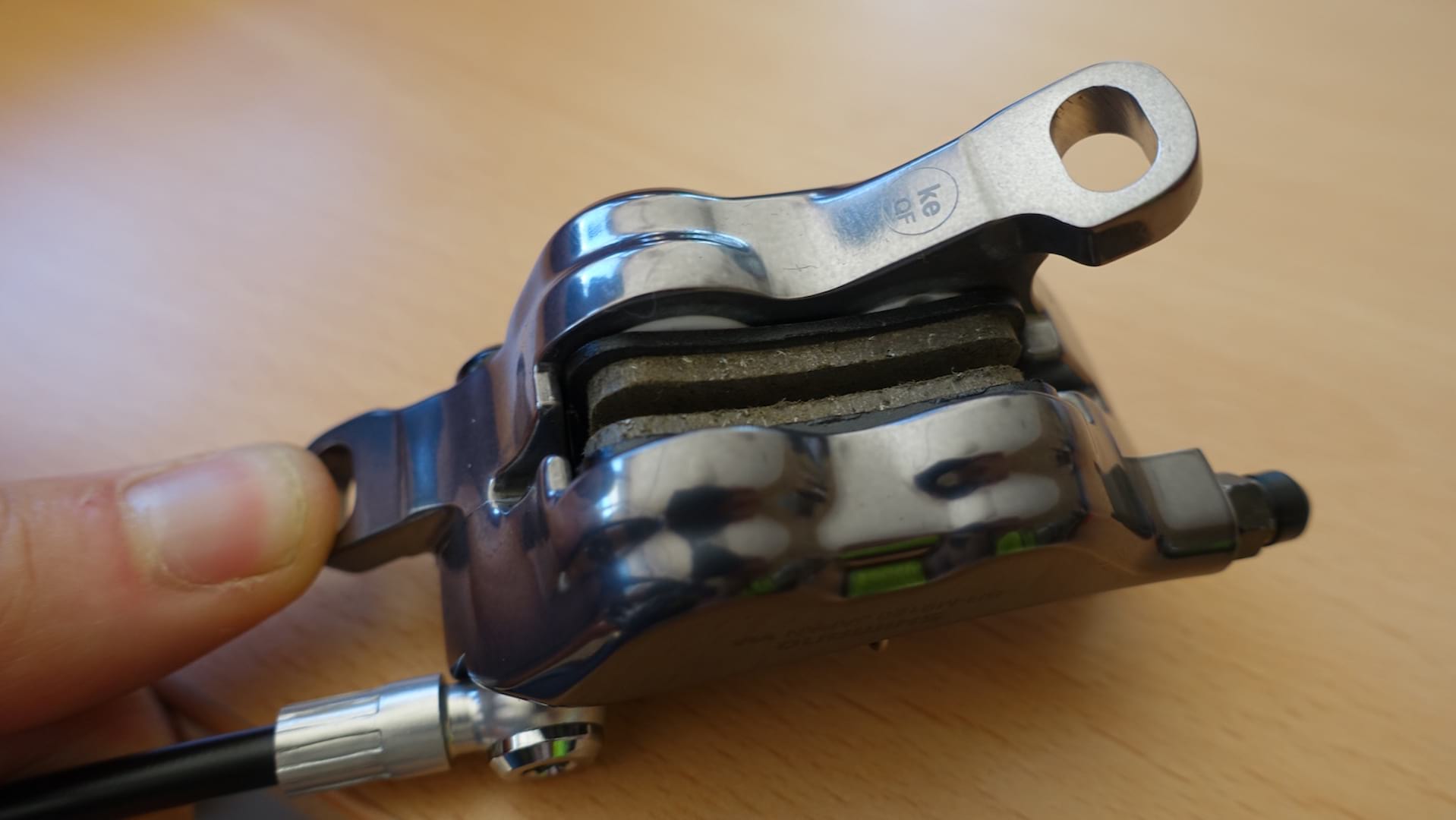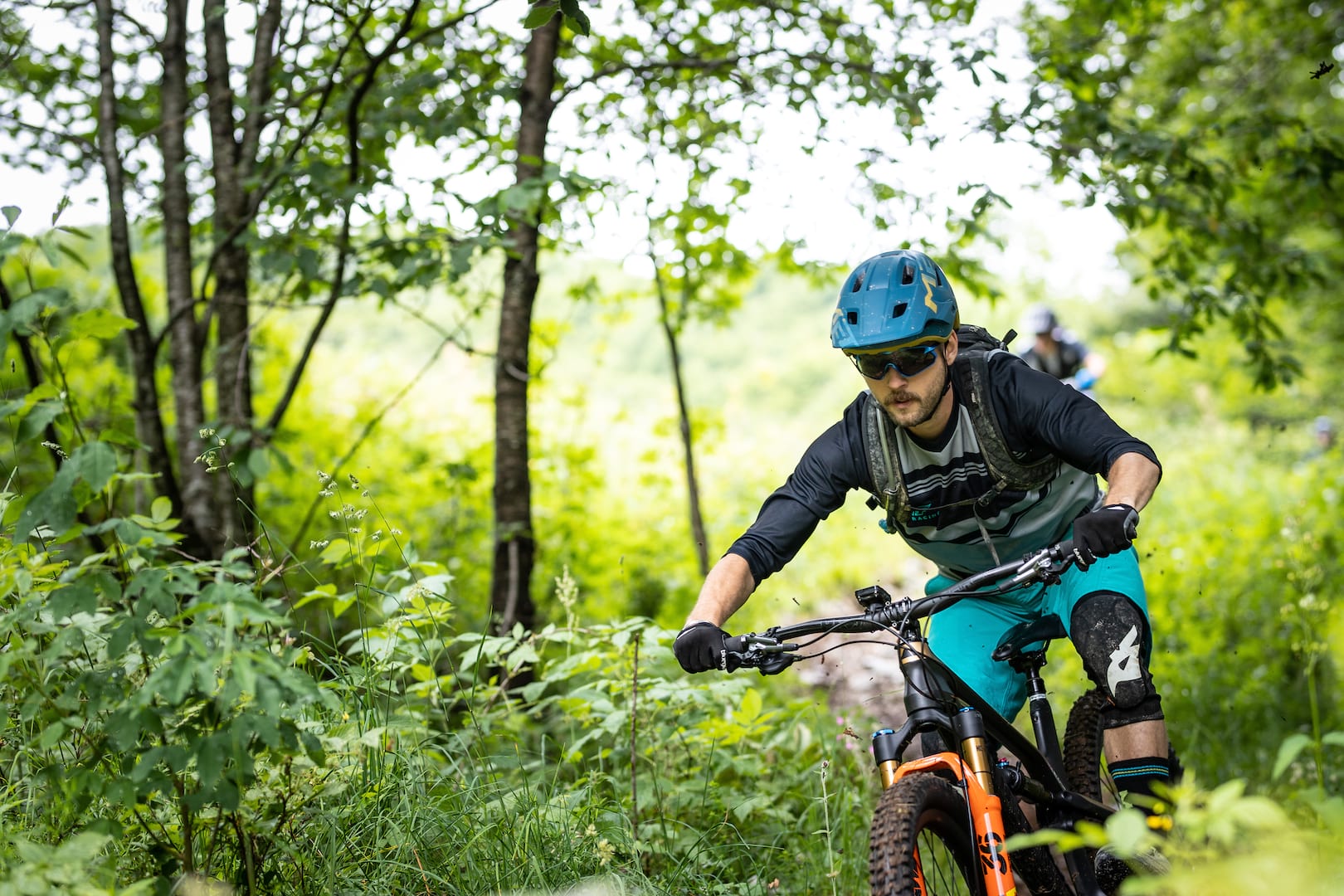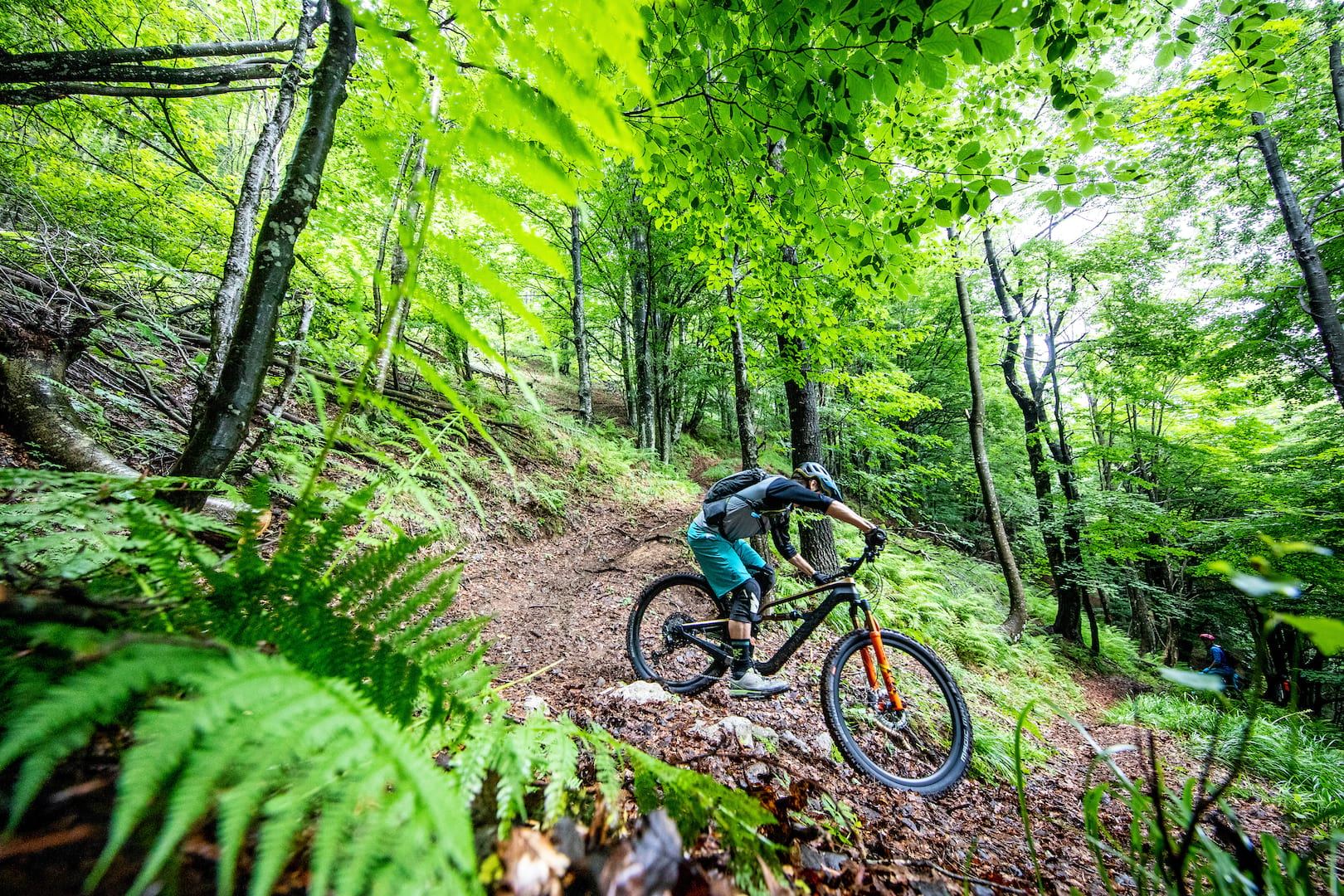Last week I was lucky to find myself in the wonderfully atmospheric Kranjska Gora in Slovenia. A location unfamiliar to this antipodean, Kranjska Gora is squeezed into the north western corner of Slovenia, right up against the intersecting border with Italy and Austria. Surrounded by thick, wooded forests and the cartoonish profile of the Julian Alps that butt up against the small alpine town, Kranjska Gora isn’t just for skiing – this place is becoming a sought-after destination for mountain bikers who are chasing adventurous backcountry-style trails.
The reason I was in Slovenia was for the Shimano XTR Media Camp, where we had some pretty incredible rides planned that would see us cross both the Italian and Austrian border. There would be be long alpine climbs for us to test out the new low-range cassette options, and there would be steep, wooded descents for us to put the brakes to the test.
Of course Shimano had already unveiled XTR during the Nove Mesto World Cup round last month, so there was nothing secret about the products we’d be riding. This, however, would be the first opportunity for journos like me to get first-hand experience of the new M9100 groupset.

During the XTR launch, I had the chance to ride two different bikes. One was a Scott Spark RC World Cup setup with a Fox 32 Step-Cast fork, a lightweight PRO cockpit, and a Shimano XTR groupset comprising a 1×12 drivetrain and the lightweight 2-piston Race brakes. On the third day of the launch I switched to a longer travel Canyon Spectral that had a Fox 36 FIT GRIP2 fork on it as well as a PRO Koryak dropper post, a 1×12 drivetrain and the bigger 4-piston Enduro disc brakes.
The drivetrain itself was identical between the two bikes, and I’ll be publishing a separate first ride article detailing my experience with that soon. Right now however, I want to take a closer look at the two brake options available in Shimano’s new XTR groupset. Here we’re going to go through the differences (big and small) between the 2-piston and 4-piston brakesets, along with my first impressions of how these brakes compare on the trail.

Shimano XTR BR-M9100 Race Disc Brakes
- New lightweight 2-piston brake designed for XC racing and trail riding
- One-piece alloy calliper
- Dual ceramic pistons
- Ice Technologies K02A non-finned resin brake pads w/titanium backing plate (finned metallic versions available separately)
- BL-M9100 levers
- Time lag reduced by 30% compared with M9000
- I-Spec EV compatible
- Magnesium body
- Carbon fibre lever blades
- Tooled reach adjustment
- BH90 high pressure hose w/straight hose connection
- Shimano Mineral Oil
- Claimed weight: 312g per end (calliper, lever & hose)
- RRP: £209 per end

For new XTR, Shimano retains two separate brake options. Known as the ‘Race’ option, the M9100 XTR brake set features a lighter weight 2-piston calliper that draws heavily on Shimano’s Dura-Ace and Ultegra road disc brakes. The single-piece body is made from alloy and is unique to XTR, but the ceramic pistons are the same diameter as what you’ll find inside the aforementioned road callipers, and the pad shape is also the same.
This is a smaller brake pad than what you’ll find in current Shimano 2-piston mountain bike brakes, such as the Deore XT, SLX, Deore and previous XTR brakes. Because it’s a shorter pad, no longer do the pads need ‘toeing in’ with an asymmetric spring – the new spring doesn’t have a left and right specific orientation. The resin pad compound itself is brand new, and according to Shimano, it’s significantly more durable than the resin pads found in Ultegra/Dura-Ace callipers. The new pad will be filtered though the road brake line in the future.
Shimano will only be offering the M9100 brake with a regular post mount – there are no plans to introduce a Flat Mount standard, which Shimano believes is better suited to road use. Unlike the bigger 4-piston callipers, the 2-piston version uses a banjo-less entry for the BH90 hydraulic hose.

Up at the lever end, magnesium is used to produce an elegantly polished lever body. The biggest change with the new XTR lever is the move to a mid-mount for the bar clamp. To stiffen things up, a curved brace sits against the handlebar (not unlike the Trickstuff Direttissima brakes we tested last year). This brace is smooth and wide profile, so it won’t damage carbon fibre bars.
There is room in between the brace and the bar clamp to slot in a dropper post lever, though this will depend on which brand you have, and how bulky the remote is. Alternatively, Shimano has a new MT800 dropper post lever that integrates with the brake lever via the I-Spec EV bracket. Yes, that is a new standard, and it’s also used on the right brake lever for integrating the shifter into the same mount.

To get the weight down, the XTR Race brake gets a carbon fibre lever blade, and ditches all the bells and whistles. There is no Free Stroke adjustment, no Servo Wave linkage, and to adjust lever reach you’ll need a wee 2mm hex key. The pared-back design does create a very lightweight brake – Shimano claim 319g per end (without rotors or adapters). In comparison to the 4-piston M9120 brakes, you get a 146g weight saving for the set.

On The Trail
Existing Shimano brake fans will be glad to hear that the excellent lever shape has been retained. The curved lever profile with its hooked end feels lovely to the touch, particularly with a one-finger braking technique.
The bite point is solid – as you’d expect from a Shimano brake – but the initial serving of power is significantly less ‘bitey’ than current 2-piston brakes from Shimano. This lack of grabiness worked well for me on the Scott Spark RC World Cup, which was fitted with some anaemic-looking Racing Ray/Ralph tyres from Schwalbe. Because we were riding some pretty steep and loose descents, the last thing I wanted was to lock up either tyre, knowing that recovery would be very unpredictable.
This didn’t prove to be an issue though – the smooth initial feel from the XTR 2-piston brakes provides a more gradual and linear delivery of power compared to beefier brakes, so you’ve got more lever range available for modulating the brake force. They were very tolerant of my nervous panic-braking.

They’re also tolerant to brake dragging, which I did a lot of on the second day when my nerves got the better of me on some slightly greasy off-camber descents. Despite holding onto the brakes most of the way down (and then nearly burning my calf on a scorching-hot rotor), the brakes remained strong, consistent and fade-free from top to bottom. No change in lever feel, and no change in brake force. For a lightweight XC brake with small pads and 160mm rotors, that really impressed me.
Because they don’t have the brute power of the XTR 4-piston or an XT 2-piston brake, there is more effort required by the rider to slow the bike down in a hurry. That said, I personally found there to be more than enough power – especially for XC racing and trail riding. Unless you’re pushing 90kg+ or you’re planning on gunning some really long and steep descents, these will likely suffice.

Shimano XTR BR-M9120 Trail Disc Brakes
- New 4-piston brake designed for trail riding and enduro racing
- Two-piece alloy calliper
- 15/17mm diameter ceramic pistons
- 10% more power (claimed) than M9020 trail brakes
- Ice Technologies N03A Resin finned pads (finned metallic versions available separately)
- BL-M9120 levers
- I-Spec EV compatible
- Servo Wave roller cam
- Magnesium body
- Alloy lever blades
- Tool-free reach adjustment
- Free Stroke adjustment
- BH90 high pressure hose w/banjo fitting
- Shimano Mineral Oil
- Claimed weight: 385g per end (calliper, lever & hose)
- RRP: £219 per end (plus rotors & adapters)

Compared to the 2-piston brakes, the M9120 (aka ‘Enduro’) brakes use a unique lever body that’s hooked up to a much chunkier 4-piston calliper. Using a two-piece alloy construction, the calliper is sleeker and lighter than Shimano’s Saint/Zee/XT 4-piston callipers, though inside you’ll find the same 15/17mm diameter ceramic pistons. The internal pad shape is also the same, so you can fit existing Saint brake pads. However, the special finned XTR pads shown here are specific to the XTR calliper – they can’t be fitted to any other Shimano brake.
Like the Race brakes, the M9120 levers aren’t ambidextrous. There’s a specific left and right brake lever, which means you’ll have to swap hoses if you need to change the lever configuration. This isn’t a consumer issue, but more of a shop and a journo issue – our multinational group saw a lot of hose swapping throughout the three days of riding. Speaking of lever compatibility, Shimano states that you can’t mix ‘n’ match levers between the Race and Enduro brakes – the Enduro lever is specifically designed to work with the Enduro calliper, and vice versa.
Just as with the pistons, the master cylinder in the XTR Enduro brake lever is the same diameter as what you’ll find in a Saint brake. That means the hydraulic ratio is the same, though the Saint lever does feature a bigger fluid reservoir and several other internal changes that make it a purpose-built downhill brake. In comparison, the XTR M9210 brakes are pitched as a powerful brake for trail riding and enduro racing.

On The Trail
To put the bigger brakes to the test, the riding on Day 3 of the XTR Media Camp contained a much longer, and at times steeper, descent that we got to ride twice over. After ascending around 500m of vertical, we turned the bikes around and ducked into a wonderful piece of singletrack that weaved its way back down the mountain via a mixture of loose loamy soil, slick off-camber turns, wet roots and rocks, and leaf-littered gulleys.
The lever feel and profile isn’t too different between the Enduro and Race brakes. With weight being less of a concern, the Enduro brakes do get a forged alloy lever blade, which should prove tougher in the event of a crash. Connecting the lever blade to the master cylinder piston is the Servo Wave roller cam, which controls the leverage curve and the rate at which oil is pushed through the hose. You can use a phillips screwdriver to adjust the Free Stroke, though I didn’t play around with this.

Very quickly, the 4-piston brakes made their increased power apparent. They are much grabbier initially compared to the 2-piston Race brakes, with the Servo Wave linkage rushing the pads towards the rotor as soon as you depress the lever blade. I locked up the tyres several times on some wet limestone at the top of the descent, resulting in some interesting two-wheel drifting.
Having spent the previous two days riding the Race brakes, it took me a good ten minutes to readjust my braking style for the added power. Once I got used to the feel though, I found them easy to control and modulate – you just have to get to know how the power changes through the lever travel.
When I came into a couple of corners too hot, the initial bite of the Enduro brakes meant I could scrub speed off in a very efficient manner. Go deeper into the lever stroke while riding longer and steeper straightline sections, and you’ll feel the power continuing to ramp up. I can’t say I found myself that far into the lever though, since there is so much power available early on. I’d even consider downsizing the rotors if I was going to use these brakes for more everyday trail riding.

As for consistency, the XTR Enduro brakes proved solid. I had one singular moment where the right lever (front brake) pumped up ever so slightly – like a millimetre or two. It was otherwise consistent and fade-free for the rest of the day, and I experienced none of the wandering bite point that I’ve had with some other Shimano brakes the past couple of years. Three other journo’s in my group experienced a similar thing, but our brake lines had been repeatedly swapped over the course of three days, so my guess is that a small bubble of air was hiding inside my front brake. Of note is that we were riding prototype hardware, and so I’m very keen to get more ride time on a set of production brakes when they’re available in August/September.
The Verdict
Both the XTR Race and Enduro brakes maintain the silky-smooth action of their predecessors, with a lovely lever feel, a firm bite point and sorted ergonomics. If you’re a fan of existing Shimano brakes, you’re not going to be disappointed here.
But which to choose?
The Race brakes impressed me with their gentle power delivery and quiet operation, and even though I tried cooking the rotors, they shrugged off the heat admirably. If you’re on the lighter side, I reckon you could get away with these on a 120mm travel trail bike, providing you’re not hitting up bikeparks or half-hour descents in the Lake District. And for the XC riders and racers, there’s no question these are the choice for you in the new XTR line.
In comparison, the Enduro brakes are hugely powerful, and are likely to appeal to heavier trail riders, competitive enduro racers, or simply those who like to frequent alpine environments on a regular basis. The additional power and heat management will be welcome on extended plummets downhill, particularly if you’re on a long travel 29er with big wheels and tyres that need more stopping force overall. More time will be needed to see how they fair in the long run, but early impressions are very favourable.

Disclosure
Shimano covered flights and accommodation for this trip.






So, Saint or XTR 4 pot for outright power?
@tomhowards – If outright power is your main goal, the Saints are still the best option in the Shimano range. The calliper is quite a bit chunkier than the XTR 4-piston callipers, and I understand there are further differences internally that make the Saint better suited to proper downhill riding.
That said, the new 4-piston XTR brakes are super dooper powerful. Ross has also been on the XT 4-piston brakes for a couple of months now, and he’s been super impressed with those – his review will be going live in the next few days, so keep your eyes peeled for that one!
ST Wil.
Will the 4pot caliper work with my m9000 series xtr trail lever?
Is it possible to mix XTR levers and calipers? Looking at building a XC/Trail bike with 120mm of travel on both ends. I like the modulation of the 9100 lever and the sheer stopping power of the 9120 caliper. I am also in the 190lb range. Are there any issues with pairing a 9100 lever with the 9120 caliper?